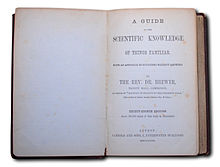A Guide to the Scientific Knowledge of Things Familiar

Title page from the 38th edition published in 1880
|
|
| Author | Ebenezer Cobham Brewer |
|---|---|
| Country | United Kingdom |
| Language | English |
| Subject | Science education |
| Publisher | Jarrold and Sons |
|
Publication date
|
1840-47? (first edition) |
A Guide to the Scientific Knowledge of Things Familiar, also known as The Guide to Science or Brewer's Guide to Science, is a book by Ebenezer Cobham Brewer presenting explanations for common phenomena. First published in the United Kingdom around 1840, the book is laid out in the style of a catechism and proved very popular. 47 editions were printed by 1905 in English alone and translations made into various other languages. A revised version was produced for the US market which was digitised and republished in 2005 as part of Making of America IV: the American voice, 1850–1877.
Although presented itself as an accurate science text, the book actually promotes religious ideas, including divine design.
The popularity of The Guide to Science enabled Brewer to gather material for his Dictionary of Phrase and Fable which remains a classic reference work.
The object of The Guide to Science was to present answers to over 2000 questions about common phenomena. There are questions dealing with the man-made objects such as candles, stoves and chimneys as well as answers seeking to explain natural phenomena such as thunder and lightning (including a mention of ball lightning), clouds, dew and rainbows. Brewer intended that his book should be intelligible to a child, since children might often ask the questions he was seeking to answer, but without being so foolish as to offend the scientific.
The book is separated into two or three parts, depending upon the edition, each part having several chapters. Part one deals with questions relating to heat such as the sources of heat and its effects on humans and animals, while Part two deals with questions relating to air, explaining why metal rusts in air, the operation of barometers and the transmission of sound. A Miscellaneous section deals with several more nebulous questions, including questions about sleep and dreaming. Within each part, the different chapters break the questions and answers up into subject areas organised thematically.
...
Wikipedia
